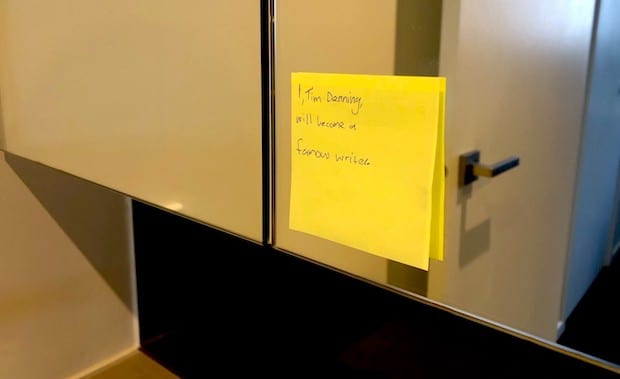Success Advice
How A Sticky Note On My Bathroom Mirror Massively Impacted My Life

Focus is a hard thing to obtain. There are just so many things buzzing around in our heads. It’s the digital age we live in.
I thought I’d have a go at focusing on one thing.
At 8 am one morning before work, I got out a yellow posted note and wrote the following:
I, Tim Denning, will become a famous writer.
As I read these words right now, I still feel a bit stupid. How could a posted note with something like this on it massively impact my life?
I didn’t believe for a second that the posted note was my savior either.
The simplest of practices often go unnoticed or dismissed as being too ‘easy.’
After sticking that posted note on my bathroom mirror, I thought nothing of it. Each day I’d walk into the bathroom, go to the toilet and brush my teeth. During these moments of nothingness, I’d stare at the mirror.
I couldn’t help but notice this bright shiny posted note staring right at me.
It was hard not to see it’s sun-like goodness.
So, each time I went to the bathroom, I’d read what was on the posted note.
The message seemed insignificant.
After placing that posted note on my mirror, without even thinking, I’d write something on my computer each time I read what was on the posted note. For a guy that drinks a lot of water, this meant lots of trips to the bathroom and even more exposure to this tiny, little, yellow posted note.
Some days it was a few written comments on LinkedIn.
Other days it was 100–200 words as an answer to a question on Quora.
On days when I had lots of energy or had something on my mind, the writing took the form of long posts on Medium.com
It didn’t matter where I was writing; it just mattered that I was writing at every chance I got.
When I read the posted note and then wrote something, I felt good.
Each time I followed my one single instruction to myself on the posted note, it made me feel a sense of achievement.
“Even if I’d achieved nothing else for the day, doing what I ‘d committed to on the posted note made everything else worth it”
Before I wrote anything on that little yellow posted note and put it on my bathroom mirror, I had conflicting priorities. There was gym, public speaking practice, research on digital marketing and 101 books to read. It was a constant struggle of willpower to work out what to focus on.
Spare time became a war in my head against conflicting priorities. The posted note on my bathroom mirror ended that war once and for all.
One thing. Clearly written. So simple, anyone could understand it.
The POINT.
All sounds good, doesn’t it?
Well, there’s a point to this story. A surprise some would say.
In the same month as I stuck this posted note on my bathroom mirror and began the practice of saying “I, Tim Denning, will become a famous writer” a surprising email made its way into my inbox.
The email read “You Are A LinkedIn Top Voice”
Some people may have no idea what this award and that’s okay.
For someone trying to become a famous writer and inspire the world through entrepreneurship and personal development, it shows a significant amount of progress towards attaining that goal.
This award meant that I was reaching millions of people every month with my writing.
That sticky note on my mirror could be described as an affirmation, a goal, an area of focus — there’s a thousand different ways to describe it.
I don’t think the name for this practice matters. What’s important about the sticky note on my mirror is that it’s a daily practice and it focuses my busy mind on one thing.
Many of you reading this have not been able to achieve that one thing in your life that you’ve always wanted because you haven’t deliberately worked towards it each day. Through no fault of your own, your mind has become distracted — partly due to the internet — and so all the other tasks in your life have got in the way.
Like me, you’ve probably thought that small practices like placing sticky notes on your mirror are stupid and so you’ve never tried it.
I’m living proof that a sticky note on your bathroom mirror can massively impact your life.
Deliberate practice and focus works and automates the process of achieving your goals.
Automate the change you’re seeking.
If you want to increase your productivity and learn some more valuable life hacks, then join my private mailing list on timdenning.net
Did You Know
How Skilled Migrants Are Building Successful Careers After Moving Countries
Behind every successful skilled migrant career is a mix of resilience, strategy, and navigating systems built for locals.

Moving to a new country for work is exciting, but it can also be unnerving. Skilled migrants leave behind familiar systems, networks, and support to pursue better job opportunities and a better future for their families. (more…)
Life
10 Research-Backed Steps to Create Real Change This New Year
This New Year could finally be the one where you break old patterns and create real, lasting change.

Every New Year, we make plans and set goals, but often repeat old patterns. (more…)
Change Your Mindset
The Silent Skill That Makes People Respect You Instantly
What truly earns respect and why most people go about it the wrong way

Everybody craves respect but not everyone earns it. Some people believe that a title, years of experience, or a position of authority automatically entitles them to respect. (more…)
Entrepreneurs
The Essential Skills Every Entrepreneur Needs In 2026
Success in the digital age isn’t about luck. It’s about mastering the skills that separate dreamers from doers.

When I was 22 years old, I started my first side hustle as a ghostwriter. (more…)
-

 Did You Know4 weeks ago
Did You Know4 weeks agoThe Success Patterns You Inherited (And Didn’t Notice)
-

 Entrepreneurs4 weeks ago
Entrepreneurs4 weeks agoThe Essential Skills Every Entrepreneur Needs In 2026
-

 Change Your Mindset3 weeks ago
Change Your Mindset3 weeks agoHow to Turn Your Mind Into Your Greatest Asset (Instead of Your Enemy)
-

 Change Your Mindset3 weeks ago
Change Your Mindset3 weeks agoThe Silent Skill That Makes People Respect You Instantly
-

 Life2 weeks ago
Life2 weeks ago10 Research-Backed Steps to Create Real Change This New Year
-

 Tech2 weeks ago
Tech2 weeks agoWhat’s in a Name? How to Get Your Domain Right
-

 Did You Know1 week ago
Did You Know1 week agoHow Skilled Migrants Are Building Successful Careers After Moving Countries
























